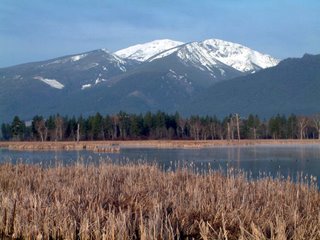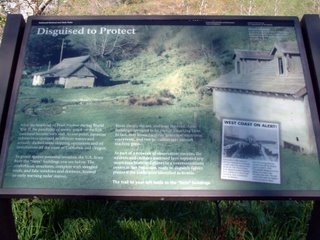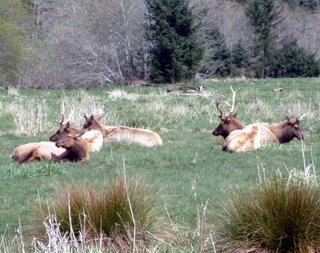 After 5000 miles and 10 states, we've arrived at our summer home at the Lee Metcalf National Wildlife Refuge in the Bitterroot Valley of Montana. We arrived on a Tuesday afternoon amid scattered snow and rain showers, marveling at the beauty of the area. We were met by Bob, the Outdoor Recreation Planner, who directed us to our brand-new concrete pad with electric, water, and sewer hookups. The next morning we met the manager and other members of the staff, a great group of people who made us feel welcome and appreciated. Our job, in turn for the use of the RV pad and hookups, is to staff the visitor center on Saturdays and Sundays, days that the center was not open in the past. The more we learned about the job, the more apprehensive we became - after all, we were supposed to answer questions about the dozens of types of birds, ducks, shorebirds, geese, and other animals. Up until now, I thought the term "duck" preceded by the appropriate color was a pretty technical description; now we discovered that they had names like Blue-winged Teal, Ruddy Ducks, Mallards, Hooded Mergansers, Coots, Loons, Grebes .......who knew?
After 5000 miles and 10 states, we've arrived at our summer home at the Lee Metcalf National Wildlife Refuge in the Bitterroot Valley of Montana. We arrived on a Tuesday afternoon amid scattered snow and rain showers, marveling at the beauty of the area. We were met by Bob, the Outdoor Recreation Planner, who directed us to our brand-new concrete pad with electric, water, and sewer hookups. The next morning we met the manager and other members of the staff, a great group of people who made us feel welcome and appreciated. Our job, in turn for the use of the RV pad and hookups, is to staff the visitor center on Saturdays and Sundays, days that the center was not open in the past. The more we learned about the job, the more apprehensive we became - after all, we were supposed to answer questions about the dozens of types of birds, ducks, shorebirds, geese, and other animals. Up until now, I thought the term "duck" preceded by the appropriate color was a pretty technical description; now we discovered that they had names like Blue-winged Teal, Ruddy Ducks, Mallards, Hooded Mergansers, Coots, Loons, Grebes .......who knew?  But equipped with a Sibley Guide to Birds and false bravado, we spent our first weekend without incident or too much embarrassment, which I attribute to the snazzy shirts that gave us both an air of credibility. We enjoyed furnishing information on the location of a pair of Bald Eagles that are feeding their young, where the resident Badger has been sighted, and the latest arrivals (Avocets) as birds continue to migrate North. In addition, we take care of a small gift shop and work a number of office projects for the staff. We're thoroughly enjoying the experience and meeting people and find that the 2 on/5 off work schedule sure beats our former work routines. We've had the chance to hike and explore the refuge and the local area, and look forward to warmer weather so that the back country roads are accessible. The refuge is located in the Bitterroot Valley which is about 10 miles wide at its widest and 100 miles long, running North to South from Missoula, surrounded by the Bitterroot mountains to the West and Emerald mountains to the East.
But equipped with a Sibley Guide to Birds and false bravado, we spent our first weekend without incident or too much embarrassment, which I attribute to the snazzy shirts that gave us both an air of credibility. We enjoyed furnishing information on the location of a pair of Bald Eagles that are feeding their young, where the resident Badger has been sighted, and the latest arrivals (Avocets) as birds continue to migrate North. In addition, we take care of a small gift shop and work a number of office projects for the staff. We're thoroughly enjoying the experience and meeting people and find that the 2 on/5 off work schedule sure beats our former work routines. We've had the chance to hike and explore the refuge and the local area, and look forward to warmer weather so that the back country roads are accessible. The refuge is located in the Bitterroot Valley which is about 10 miles wide at its widest and 100 miles long, running North to South from Missoula, surrounded by the Bitterroot mountains to the West and Emerald mountains to the East.  With over 2800 acres and numerous ponds and streams, the refuge provides a valuable resting area for migrating wildfowl and also hosts a large population of local wildlife. Columbian Ground Squirrels (looks like a fox squirrel with a short tail), Ring-neck Pheasant, Coyote, and a lots of White-tail deer are common sights. Looking out our windshield is sometimes like watching a version of "Wild Kingdom", with Great Blue Heron hunting rodents, Coyote stalking Pheasants, and Red Tail Hawks and Osprey looking for mice and voles. In the coming weeks we hope to explore Missoula, LoLo Pass to the West, and some of the hiking trails in the lower elevations. Keep checking our site, now that we're settled in I'll try to update it every week. Thanks again for keeping in touch and we hope you'll come visit!
With over 2800 acres and numerous ponds and streams, the refuge provides a valuable resting area for migrating wildfowl and also hosts a large population of local wildlife. Columbian Ground Squirrels (looks like a fox squirrel with a short tail), Ring-neck Pheasant, Coyote, and a lots of White-tail deer are common sights. Looking out our windshield is sometimes like watching a version of "Wild Kingdom", with Great Blue Heron hunting rodents, Coyote stalking Pheasants, and Red Tail Hawks and Osprey looking for mice and voles. In the coming weeks we hope to explore Missoula, LoLo Pass to the West, and some of the hiking trails in the lower elevations. Keep checking our site, now that we're settled in I'll try to update it every week. Thanks again for keeping in touch and we hope you'll come visit!

We're now on the final leg of our travels before settling into our summer job in Montana. Leaving Gilroy we managed to transit the San Francisco Bay area without incident and spend a forgettable night at an overpriced KOA campground in Willits. Heading north, we entered giant redwood country on highway 101; lots of hills, twists, turns, rivers, and beautiful scenery. We arrived in Klamath in the rain and pulled into an RV park on the river. The first thing we noticed in the office was the water mark three feet above the floor; it turns out the entire area was flooded in December and they were still rebuilding. We were one of only four RVs there, so we were led to a good spot on solid ground. From there we explored Klamath, which is a small town, mostly populated by Yurok Indians, where the people rely on commercial and sport salmon fishing. You may have read of the dispute between farmers of the Klamath Valley who need the water for agriculture and the Yurok tribe which needs the unrestricted flow of water to allow salmon to return to the streams and spawn. Due to a combination of factors, the commercial fishery will be pretty much closed this year, so a lot of the local economy will be affected. Economics aside, the area is beautiful and we enjoyed exploring both the coast and the redwood forests. An interesting discovery while driving a dirt road along the coast was a WWII coastal radar site disguised as a farm. The buildings have been restored to their original condition, although the radar and machine guns have been removed and the buildings sealed. 
 The coastline here is noteworthy for its rocky coastline and numerous rivers that flow from the mountains. We enjoyed walking the beach and watched this fisherman working hard to get his bait out beyond the first line of breakers.
The coastline here is noteworthy for its rocky coastline and numerous rivers that flow from the mountains. We enjoyed walking the beach and watched this fisherman working hard to get his bait out beyond the first line of breakers.  Off in the distance, the mountains still were getting snow.
Off in the distance, the mountains still were getting snow.  Hiking the trails through the redwoods, surrounded by huge trees and dense ferns, with mist and rain, was an incredible, almost surreal experience. It's impossible to take a picture which accurately portrays the size of these huge trees; they're just too large. Although not quite as big as their giant sequoia cousins in girth, they are often taller. There are redwood "groves" designated throughout the area, and we especially enjoyed the Stout Grove outside of Crescent City.
Hiking the trails through the redwoods, surrounded by huge trees and dense ferns, with mist and rain, was an incredible, almost surreal experience. It's impossible to take a picture which accurately portrays the size of these huge trees; they're just too large. Although not quite as big as their giant sequoia cousins in girth, they are often taller. There are redwood "groves" designated throughout the area, and we especially enjoyed the Stout Grove outside of Crescent City. 
 We had an opportunity to see elk throughout the area, and one night were surprised to see a mountain lion feeding on an elk carcass in a field; unfortunately, I wasn't quick enough to get a picture before he ambled off into the woods. At Winchester Bay, another picturesque seaport, we watched Killer Whales play offshore and went to sleep to the crash of waves against the breakwall. Beautiful scenery, wildlife, huge trees, and great seafood make this an area we're sure to return to again. For now, we're in Spokane getting ready to leave for Montana. Thanks for checking on us & please stay in touch!
We had an opportunity to see elk throughout the area, and one night were surprised to see a mountain lion feeding on an elk carcass in a field; unfortunately, I wasn't quick enough to get a picture before he ambled off into the woods. At Winchester Bay, another picturesque seaport, we watched Killer Whales play offshore and went to sleep to the crash of waves against the breakwall. Beautiful scenery, wildlife, huge trees, and great seafood make this an area we're sure to return to again. For now, we're in Spokane getting ready to leave for Montana. Thanks for checking on us & please stay in touch!

 After 5000 miles and 10 states, we've arrived at our summer home at the Lee Metcalf National Wildlife Refuge in the Bitterroot Valley of Montana. We arrived on a Tuesday afternoon amid scattered snow and rain showers, marveling at the beauty of the area. We were met by Bob, the Outdoor Recreation Planner, who directed us to our brand-new concrete pad with electric, water, and sewer hookups. The next morning we met the manager and other members of the staff, a great group of people who made us feel welcome and appreciated. Our job, in turn for the use of the RV pad and hookups, is to staff the visitor center on Saturdays and Sundays, days that the center was not open in the past. The more we learned about the job, the more apprehensive we became - after all, we were supposed to answer questions about the dozens of types of birds, ducks, shorebirds, geese, and other animals. Up until now, I thought the term "duck" preceded by the appropriate color was a pretty technical description; now we discovered that they had names like Blue-winged Teal, Ruddy Ducks, Mallards, Hooded Mergansers, Coots, Loons, Grebes .......who knew?
After 5000 miles and 10 states, we've arrived at our summer home at the Lee Metcalf National Wildlife Refuge in the Bitterroot Valley of Montana. We arrived on a Tuesday afternoon amid scattered snow and rain showers, marveling at the beauty of the area. We were met by Bob, the Outdoor Recreation Planner, who directed us to our brand-new concrete pad with electric, water, and sewer hookups. The next morning we met the manager and other members of the staff, a great group of people who made us feel welcome and appreciated. Our job, in turn for the use of the RV pad and hookups, is to staff the visitor center on Saturdays and Sundays, days that the center was not open in the past. The more we learned about the job, the more apprehensive we became - after all, we were supposed to answer questions about the dozens of types of birds, ducks, shorebirds, geese, and other animals. Up until now, I thought the term "duck" preceded by the appropriate color was a pretty technical description; now we discovered that they had names like Blue-winged Teal, Ruddy Ducks, Mallards, Hooded Mergansers, Coots, Loons, Grebes .......who knew?  But equipped with a Sibley Guide to Birds and false bravado, we spent our first weekend without incident or too much embarrassment, which I attribute to the snazzy shirts that gave us both an air of credibility. We enjoyed furnishing information on the location of a pair of Bald Eagles that are feeding their young, where the resident Badger has been sighted, and the latest arrivals (Avocets) as birds continue to migrate North. In addition, we take care of a small gift shop and work a number of office projects for the staff. We're thoroughly enjoying the experience and meeting people and find that the 2 on/5 off work schedule sure beats our former work routines. We've had the chance to hike and explore the refuge and the local area, and look forward to warmer weather so that the back country roads are accessible. The refuge is located in the Bitterroot Valley which is about 10 miles wide at its widest and 100 miles long, running North to South from Missoula, surrounded by the Bitterroot mountains to the West and Emerald mountains to the East.
But equipped with a Sibley Guide to Birds and false bravado, we spent our first weekend without incident or too much embarrassment, which I attribute to the snazzy shirts that gave us both an air of credibility. We enjoyed furnishing information on the location of a pair of Bald Eagles that are feeding their young, where the resident Badger has been sighted, and the latest arrivals (Avocets) as birds continue to migrate North. In addition, we take care of a small gift shop and work a number of office projects for the staff. We're thoroughly enjoying the experience and meeting people and find that the 2 on/5 off work schedule sure beats our former work routines. We've had the chance to hike and explore the refuge and the local area, and look forward to warmer weather so that the back country roads are accessible. The refuge is located in the Bitterroot Valley which is about 10 miles wide at its widest and 100 miles long, running North to South from Missoula, surrounded by the Bitterroot mountains to the West and Emerald mountains to the East.  With over 2800 acres and numerous ponds and streams, the refuge provides a valuable resting area for migrating wildfowl and also hosts a large population of local wildlife. Columbian Ground Squirrels (looks like a fox squirrel with a short tail), Ring-neck Pheasant, Coyote, and a lots of White-tail deer are common sights. Looking out our windshield is sometimes like watching a version of "Wild Kingdom", with Great Blue Heron hunting rodents, Coyote stalking Pheasants, and Red Tail Hawks and Osprey looking for mice and voles. In the coming weeks we hope to explore Missoula, LoLo Pass to the West, and some of the hiking trails in the lower elevations. Keep checking our site, now that we're settled in I'll try to update it every week. Thanks again for keeping in touch and we hope you'll come visit!
With over 2800 acres and numerous ponds and streams, the refuge provides a valuable resting area for migrating wildfowl and also hosts a large population of local wildlife. Columbian Ground Squirrels (looks like a fox squirrel with a short tail), Ring-neck Pheasant, Coyote, and a lots of White-tail deer are common sights. Looking out our windshield is sometimes like watching a version of "Wild Kingdom", with Great Blue Heron hunting rodents, Coyote stalking Pheasants, and Red Tail Hawks and Osprey looking for mice and voles. In the coming weeks we hope to explore Missoula, LoLo Pass to the West, and some of the hiking trails in the lower elevations. Keep checking our site, now that we're settled in I'll try to update it every week. Thanks again for keeping in touch and we hope you'll come visit!








